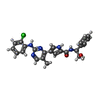| 登録情報 | データベース: PDB / ID: 3i60
|
|---|
| タイトル | Crystal structure of ERK2 bound to (S)-4-(2-(2-chlorophenylamino)-5-methylpyrimidin-4-yl)-N-(2-hydroxy-1-phenylethyl)-1H-pyrrole-2-carboxamide |
|---|
 要素 要素 | Mitogen-activated protein kinase 1 |
|---|
 キーワード キーワード | TRANSFERASE / kinase / inhibitor / ATP-binding / Cell cycle / Host-virus interaction / Nucleotide-binding / Phosphoprotein / Serine/threonine-protein kinase |
|---|
| 機能・相同性 |  機能・相同性情報 機能・相同性情報
phospho-PLA2 pathway / interleukin-34-mediated signaling pathway / Signaling by MAPK mutants / RAF-independent MAPK1/3 activation / Suppression of apoptosis / Gastrin-CREB signalling pathway via PKC and MAPK / Signaling by Activin / cardiac neural crest cell development involved in heart development / caveolin-mediated endocytosis / cytosine metabolic process ...phospho-PLA2 pathway / interleukin-34-mediated signaling pathway / Signaling by MAPK mutants / RAF-independent MAPK1/3 activation / Suppression of apoptosis / Gastrin-CREB signalling pathway via PKC and MAPK / Signaling by Activin / cardiac neural crest cell development involved in heart development / caveolin-mediated endocytosis / cytosine metabolic process / response to epidermal growth factor / Signaling by NODAL / ERKs are inactivated / Signaling by MAP2K mutants / RSK activation / Regulation of the apoptosome activity / Golgi Cisternae Pericentriolar Stack Reorganization / positive regulation of macrophage proliferation / regulation of cellular pH / outer ear morphogenesis / Signaling by LTK in cancer / regulation of Golgi inheritance / positive regulation of peptidyl-threonine phosphorylation / ERBB signaling pathway / labyrinthine layer blood vessel development / mammary gland epithelial cell proliferation / trachea formation / Negative feedback regulation of MAPK pathway / regulation of early endosome to late endosome transport / IFNG signaling activates MAPKs / regulation of stress-activated MAPK cascade / Frs2-mediated activation / ERBB2-ERBB3 signaling pathway / Activation of the AP-1 family of transcription factors / regulation of cytoskeleton organization / ERK/MAPK targets / RUNX2 regulates osteoblast differentiation / response to exogenous dsRNA / positive regulation of macrophage chemotaxis / MAPK1 (ERK2) activation / face development / lung morphogenesis / pseudopodium / Bergmann glial cell differentiation / Recycling pathway of L1 / positive regulation of telomere maintenance / thyroid gland development / Advanced glycosylation endproduct receptor signaling / peptidyl-threonine phosphorylation / MAP kinase activity / regulation of ossification / negative regulation of cell differentiation / Regulation of HSF1-mediated heat shock response / RHO GTPases Activate NADPH Oxidases / mitogen-activated protein kinase / Estrogen-dependent nuclear events downstream of ESR-membrane signaling / RHO GTPases Activate WASPs and WAVEs / Signal attenuation / phosphatase binding / Growth hormone receptor signaling / Schwann cell development / Estrogen-stimulated signaling through PRKCZ / stress-activated MAPK cascade / Nuclear events stimulated by ALK signaling in cancer / ERK1 and ERK2 cascade / NPAS4 regulates expression of target genes / phosphotyrosine residue binding / myelination / NCAM signaling for neurite out-growth / RNA polymerase II CTD heptapeptide repeat kinase activity / Transcriptional and post-translational regulation of MITF-M expression and activity / insulin-like growth factor receptor signaling pathway / ESR-mediated signaling / cellular response to amino acid starvation / lipopolysaccharide-mediated signaling pathway / thymus development / Regulation of PTEN gene transcription / Signal transduction by L1 / B cell receptor signaling pathway / response to nicotine / FCGR3A-mediated phagocytosis / FCERI mediated MAPK activation / Negative regulation of FGFR3 signaling / Negative regulation of FGFR2 signaling / Negative regulation of FGFR4 signaling / Downregulation of SMAD2/3:SMAD4 transcriptional activity / Negative regulation of FGFR1 signaling / SMAD2/SMAD3:SMAD4 heterotrimer regulates transcription / positive regulation of cholesterol biosynthetic process / Spry regulation of FGF signaling / Signaling by high-kinase activity BRAF mutants / MAP2K and MAPK activation / Oncogene Induced Senescence / regulation of protein stability / Regulation of actin dynamics for phagocytic cup formation / caveola / epidermal growth factor receptor signaling pathway / long-term synaptic potentiation / Interferon gamma signaling / chemotaxis類似検索 - 分子機能 Mitogen-activated protein (MAP) kinase, ERK1/2 / Mitogen-activated protein (MAP) kinase, conserved site / MAP kinase signature. / : / Phosphorylase Kinase; domain 1 / Phosphorylase Kinase; domain 1 / Transferase(Phosphotransferase) domain 1 / Transferase(Phosphotransferase); domain 1 / Serine/threonine-protein kinase, active site / Serine/Threonine protein kinases active-site signature. ...Mitogen-activated protein (MAP) kinase, ERK1/2 / Mitogen-activated protein (MAP) kinase, conserved site / MAP kinase signature. / : / Phosphorylase Kinase; domain 1 / Phosphorylase Kinase; domain 1 / Transferase(Phosphotransferase) domain 1 / Transferase(Phosphotransferase); domain 1 / Serine/threonine-protein kinase, active site / Serine/Threonine protein kinases active-site signature. / Protein kinase domain / Serine/Threonine protein kinases, catalytic domain / Protein kinase, ATP binding site / Protein kinases ATP-binding region signature. / Protein kinase domain profile. / Protein kinase domain / Protein kinase-like domain superfamily / 2-Layer Sandwich / Orthogonal Bundle / Mainly Alpha / Alpha Beta類似検索 - ドメイン・相同性 Chem-E86 / Mitogen-activated protein kinase 1類似検索 - 構成要素 |
|---|
| 生物種 |  Homo sapiens (ヒト) Homo sapiens (ヒト) |
|---|
| 手法 |  X線回折 / X線回折 /  フーリエ合成 / 解像度: 2.5 Å フーリエ合成 / 解像度: 2.5 Å |
|---|
 データ登録者 データ登録者 | Jacobs, M.D. / Xie, X. |
|---|
 引用 引用 |  ジャーナル: J.Med.Chem. / 年: 2009 ジャーナル: J.Med.Chem. / 年: 2009
タイトル: Structure-guided design of potent and selective pyrimidylpyrrole inhibitors of extracellular signal-regulated kinase (ERK) using conformational control.
著者: Aronov, A.M. / Tang, Q. / Martinez-Botella, G. / Bemis, G.W. / Cao, J. / Chen, G. / Ewing, N.P. / Ford, P.J. / Germann, U.A. / Green, J. / Hale, M.R. / Jacobs, M. / Janetka, J.W. / Maltais, F. ...著者: Aronov, A.M. / Tang, Q. / Martinez-Botella, G. / Bemis, G.W. / Cao, J. / Chen, G. / Ewing, N.P. / Ford, P.J. / Germann, U.A. / Green, J. / Hale, M.R. / Jacobs, M. / Janetka, J.W. / Maltais, F. / Markland, W. / Namchuk, M.N. / Nanthakumar, S. / Poondru, S. / Straub, J. / ter Haar, E. / Xie, X. |
|---|
| 履歴 | | 登録 | 2009年7月6日 | 登録サイト: RCSB / 処理サイト: RCSB |
|---|
| 改定 1.0 | 2010年1月12日 | Provider: repository / タイプ: Initial release |
|---|
| 改定 1.1 | 2011年7月13日 | Group: Advisory / Refinement description / Version format compliance |
|---|
| 改定 1.2 | 2017年11月1日 | Group: Refinement description / カテゴリ: software |
|---|
| 改定 1.3 | 2024年2月21日 | Group: Data collection / Database references / Derived calculations
カテゴリ: chem_comp_atom / chem_comp_bond ...chem_comp_atom / chem_comp_bond / database_2 / struct_ref_seq_dif / struct_site
Item: _database_2.pdbx_DOI / _database_2.pdbx_database_accession ..._database_2.pdbx_DOI / _database_2.pdbx_database_accession / _struct_ref_seq_dif.details / _struct_site.pdbx_auth_asym_id / _struct_site.pdbx_auth_comp_id / _struct_site.pdbx_auth_seq_id |
|---|
| 改定 1.4 | 2024年4月3日 | Group: Refinement description / カテゴリ: pdbx_initial_refinement_model |
|---|
|
|---|
 データを開く
データを開く 基本情報
基本情報 要素
要素 キーワード
キーワード 機能・相同性情報
機能・相同性情報 Homo sapiens (ヒト)
Homo sapiens (ヒト) X線回折 /
X線回折 /  フーリエ合成 / 解像度: 2.5 Å
フーリエ合成 / 解像度: 2.5 Å  データ登録者
データ登録者 引用
引用 ジャーナル: J.Med.Chem. / 年: 2009
ジャーナル: J.Med.Chem. / 年: 2009 構造の表示
構造の表示 Molmil
Molmil Jmol/JSmol
Jmol/JSmol ダウンロードとリンク
ダウンロードとリンク ダウンロード
ダウンロード 3i60.cif.gz
3i60.cif.gz PDBx/mmCIF形式
PDBx/mmCIF形式 pdb3i60.ent.gz
pdb3i60.ent.gz PDB形式
PDB形式 3i60.json.gz
3i60.json.gz PDBx/mmJSON形式
PDBx/mmJSON形式 その他のダウンロード
その他のダウンロード 3i60_validation.pdf.gz
3i60_validation.pdf.gz wwPDB検証レポート
wwPDB検証レポート 3i60_full_validation.pdf.gz
3i60_full_validation.pdf.gz 3i60_validation.xml.gz
3i60_validation.xml.gz 3i60_validation.cif.gz
3i60_validation.cif.gz https://data.pdbj.org/pub/pdb/validation_reports/i6/3i60
https://data.pdbj.org/pub/pdb/validation_reports/i6/3i60 ftp://data.pdbj.org/pub/pdb/validation_reports/i6/3i60
ftp://data.pdbj.org/pub/pdb/validation_reports/i6/3i60 リンク
リンク 集合体
集合体
 要素
要素 Homo sapiens (ヒト) / 遺伝子: ERK2, MAPK1, PRKM1, PRKM2 / プラスミド: pT7BLUE / 発現宿主:
Homo sapiens (ヒト) / 遺伝子: ERK2, MAPK1, PRKM1, PRKM2 / プラスミド: pT7BLUE / 発現宿主: 
 X線回折 / 使用した結晶の数: 1
X線回折 / 使用した結晶の数: 1  試料調製
試料調製 回転陽極 / タイプ: RIGAKU / 波長: 1.54 Å
回転陽極 / タイプ: RIGAKU / 波長: 1.54 Å 解析
解析 フーリエ合成
フーリエ合成 ムービー
ムービー コントローラー
コントローラー






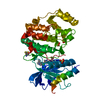


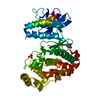

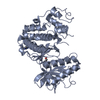
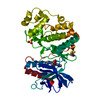

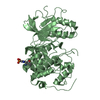

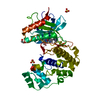



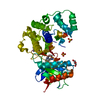

 PDBj
PDBj
































